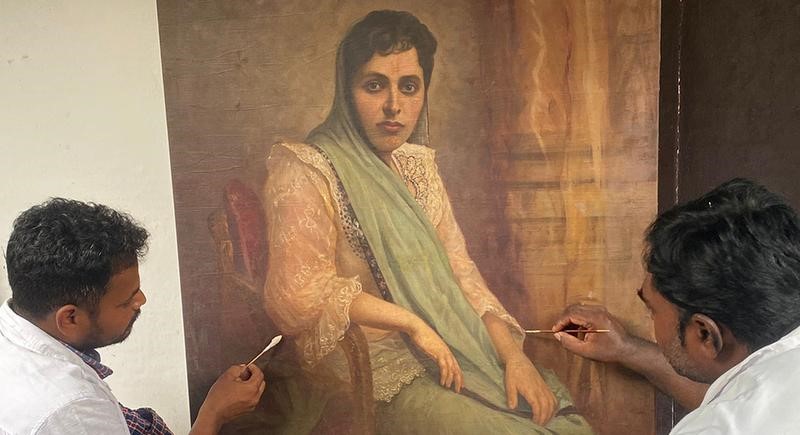Description

Disclaimer: Copyright infringement not intended
Context
- An unfinished painting by Raja Ravi Varma, who redefined Indian art traditions during the colonial times, will soon be in the public domain.
Details
- The painting ‘Parsi Lady’, now owned by the Kilimanoor Palace Trust, was the last painting (unfinished) by the legendary artist.
- He died on October 2, 1906, inside ‘Chithrashala,’ the artist’s studio at Kilimanoor Palace, leaving the painting unfinished.
- Now, the Palace Trust has decided to unveil the painting along on the occasion of the 175th birth anniversary of Ravi Varma, who was born into the aristocracy at Kilimanoor in the erstwhile Travancore on April 29, 1848.

About Raja Ravi Varma
- He was an Indian painter and artist, considered as one of the greatest painters in the history of Indian art.
- Raja Ravi Varma is known for his amazing paintings, which revolve mainly around the Puranas (ancient mythological stories) and the great Indian epics - Mahabharata and Ramayana.
- Ravi Varma is one of the few painters who managed to accomplish a beautiful union of Indian tradition with the techniques of European academic art.
- More often than not, Varma’s paintings highlighted the beauty of South Indian women which were admired by all.
- His portrayal of Hindu gods and goddesses went on to become worship material for many people belonging to the lower castes.
- Viceroy Lord Curzon honored him with the Kaisar-i-Hind Gold Medal for his service in the furtherance of public interest.
His paintings
- His paintings can be classified into three categories – portraits, portrait-based compositions and theatrical compositions based on myths and legends.
- It is the third category of paintings for which Raja Ravi Varma is most renowned.
Great Paintings of Raja Ravi Varma
- A Family of Beggars – This painting represented the sorry state of Indian economics.
- A Lady Playing Swarbat – Just like many of his paintings, this too, was modelled after a South Indian woman.
- Arjuna and Subhadra – This painting narrates a story from the Hindu epic Mahabharata.
- Damayanti Talking to a Swan – This too is a scene straight out of Mahabharata.
- Draupadi Dreading to meet Kichaka – Once again, this picture narrates a story from Mahabharata.
- Girl in Sage Kanwa's Hermitage (Rishi-Kanya) – This story talks about the story of Shakuntala.
- Jatayu (a bird devotee of Lord Rama) – This is perhaps one of the most commonly featured work of Raja Ravi Varma. The picture narrates the story of Jatayu who gives up its life after fighting the mighty villain Ravana from Ramayanam.
- Lady Giving Alms at the Temple – This is a common sight even in the present day India.
- Lady Lost in Thought – Once again this painting was modelled after a South Indian woman.
- Lady with Fruit – Probably modelled after Ravi Varma’s mistress, this painting gives you an impression that it was one of Varma’s personal favorite.
- Lord Krishna as Ambassador – This is one of those painting that depicted a Hindu deity.
- Lord Rama Conquers Varuna – After ‘Jatayu’ this is probably the most famous among the ones that narrates the story of Ramayanam.
- Nair Woman – As the name suggests, this painting portrays a Malayali woman in all her glory.
- Romancing Couple – This painting goes on to show that Raja Ravi Varma was not a painter who limited himself to depicting only gods and goddesses.
- Shakuntala – This painting depicts the legendary woman Shakuntala who marries Dushyanta. The couple later gave birth to Bharata after whom ancient India was named.
- Shakuntala Composing a Love Letter to King Dushyanta – This depicts the love story of Shakuntala and King Dushyanta.
- Shantanu and Matsyagandha – This story from Mahabharata depicts the interaction between Shantanu and Matsyagandha.
- The Heartbroken – This painting depicts a South Indian woman who looks extremely disappointed.
- The Orchestra – This depicts a band of musicians from South India.
- Victory of Maghanada (Indrajit) – This painting depicts the triumph of Lanka prince Indrajit over Indra Loka. The story is mentioned in the Indian epic Ramayana.

Criticism
- Raja Ravi Varma is often criticized for being too showy in his paintings.
- His paintings are also condemned for overshadowing traditional Indian art forms, especially the ones depicting Hindu gods and goddesses.
- Raja Ravi Varma's approach is said to lack the dynamism of expression seen in the traditional paintings.
- Critics have also criticized him for modelling goddesses after prostitutes, saying that his representation of deities have reduced them to the level of mortals.
- He was also fiercely criticized for depicting Indian women, especially women from Hindu mythologies with pale skin. It was always the lower class women who took the honor of flaunting dark skin in his paintings.
Legacy
- Many movies have been made and novels written on the ostentatious life of Raja Ravi Varma.
- Out of those, Bollywood film ‘Rang Rasiya’ and Malayalam movie ‘Makaramanju’ are the most popular ones.
- Based on the novel ‘Raja Ravi Varma’, written by Ranjit Desai, the Maharashtra State Board included a chapter titled 'A Meeting Like Never Before' in one of its Marathi textbooks.
|
PRACTICE QUESTION
Q) Discuss the contribution of Raja Ravi Varma to Indian Art. (150 words)
|

https://epaper.thehindu.com/ccidist-ws/th/th_delhi/issues/34319/OPS/GO9B5TNU3.1+GRUB5TSGL.1.html
















